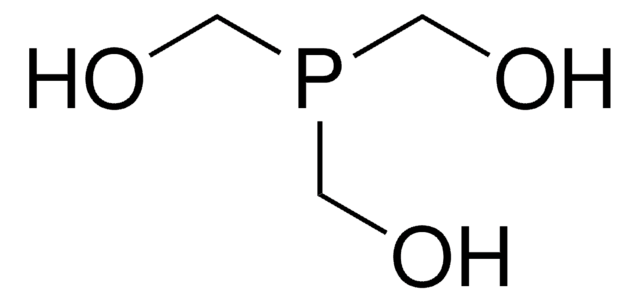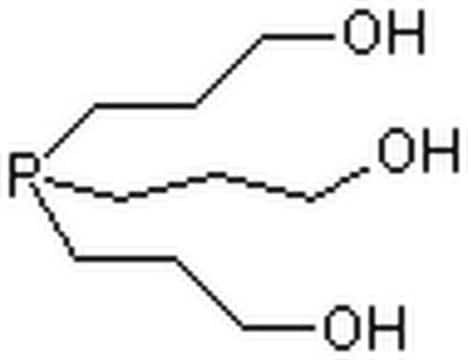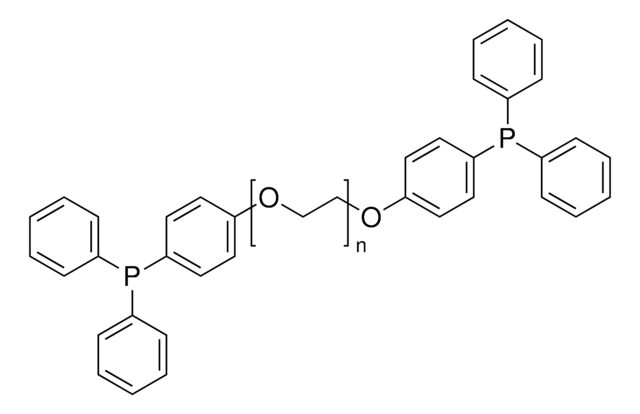777854
Tris(hydroxypropyl)phosphine
≥80%
Synonym(s):
THPP
Sign Into View Organizational & Contract Pricing
All Photos(3)
About This Item
Empirical Formula (Hill Notation):
C9H21O3P
CAS Number:
Molecular Weight:
208.24
MDL number:
UNSPSC Code:
12352128
PubChem Substance ID:
NACRES:
NA.22
Recommended Products
Assay
≥80%
form
liquid
reaction suitability
reagent type: reductant
density
1.136 g/mL at 25 °C
SMILES string
OCCCP(CCCO)CCCO
InChI
1S/C9H21O3P/c10-4-1-7-13(8-2-5-11)9-3-6-12/h10-12H,1-9H2
InChI key
YICAEXQYKBMDNH-UHFFFAOYSA-N
General description
Tris(hydroxypropyl)phosphine (THPP) is a reducing agent widely used for the reductive cleavage of disulfide bonds in small molecules in both aqueous–organic media.
Application
Tris(hydroxypropyl)phosphine can be used:
- As a reducing agent in the reduction of dehydroascorbic acid to ascorbic acid
- In the cleavage of disulfide bonds in small molecules
- As a catalyst in the conversion of polysulfides
Signal Word
Danger
Hazard Statements
Precautionary Statements
Hazard Classifications
Skin Corr. 1B
Storage Class Code
8A - Combustible corrosive hazardous materials
WGK
WGK 3
Flash Point(F)
Not applicable
Flash Point(C)
Not applicable
Certificates of Analysis (COA)
Search for Certificates of Analysis (COA) by entering the products Lot/Batch Number. Lot and Batch Numbers can be found on a product’s label following the words ‘Lot’ or ‘Batch’.
Already Own This Product?
Find documentation for the products that you have recently purchased in the Document Library.
Customers Also Viewed
Tris (3-hydroxypropyl) phosphine (THPP): A mild, air-stable reagent for the rapid, reductive cleavage of small-molecule disulfides.
McNulty J, et al.
Bioorganic & Medicinal Chemistry Letters, 25(19), 4114-4117 (2015)
One-Pot Peptide Ligation-Oxidative Cyclization Protocol for the Preparation of Short-/Medium-Size Disulfide Cyclopeptides.
Spengler J, et al.
Organic Letters, 20(14), 4306-4309 (2018)
Designing dendritic polymers containing phosphorus donor ligands and their corresponding transition metal complexes.
Dasgupta M, et al.
Coordination Chemistry Reviews, 233(19), 223-235 (2002)
Suttipong Suttapitugsakul et al.
Molecular bioSystems, 13(12), 2574-2582 (2017-10-12)
Mass spectrometry (MS) has become an increasingly important technique to analyze proteins. In popular bottom-up MS-based proteomics, reduction and alkylation are routine steps to facilitate peptide identification. However, incomplete reactions and side reactions may occur, which compromise the experimental results.
Hairong Wang et al.
Biomaterials, 181, 310-317 (2018-08-11)
Tumor hypoxia is known to be one of critical factors that aggravate the tumor resistance to photodynamic therapy (PDT) in which oxygen is essential for tumor destruction. Herein, catalase, an enzyme to trigger hydrogen peroxide (H2O2) decomposition, is modified by
Our team of scientists has experience in all areas of research including Life Science, Material Science, Chemical Synthesis, Chromatography, Analytical and many others.
Contact Technical Service















